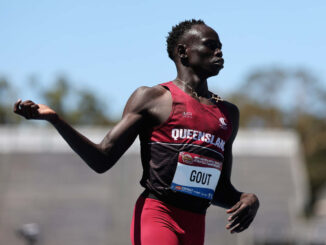
Sydney McLaughlin-Levrone was the first to take the leap, but not everyone followed suit. When Grand Slam Track (GST) launched, doubts surfaced would top athletes like Noah Lyles and Sha’Carri Richardson buy into the vision? Michael Johnson, the mastermind behind GST, acknowledges the skepticism but remains focused on the 48 elite athletes who did sign up. With four high-stakes events ahead, GST is poised to redefine track and field. However, before that journey unfolds, Johnson has a message for the doubters.
The launch of GST was never about securing every major name immediately it was about creating something groundbreaking and letting athletes choose for themselves. In an interview with Citius Mag founder Chris Chavez, four-time Olympic gold medalist Michael Johnson shared insights into GST, from ensuring business success in its first year to engaging fans in ways track and field hasn’t before.
When asked about concerns athletes had before joining, Johnson kept it simple: “When we build it, they come.” He never expected every top athlete to join in the first year, acknowledging that major shifts take time. He emphasized, “Are all of the athletes going to come in Year One? Come on, no.” While Lyles and others may have sat this one out, that could change next year. Instead of dwelling on absences, Johnson highlights those who showed up, saying, “Focusing too much on who’s missing is somewhat disrespectful to the 48 athletes here.” These aren’t just any competitors they’re Olympic and world champions shaping history.
Despite initial skepticism, GST is gaining momentum. “This has never happened in track and field,” Johnson reminds us, making it clear that something truly revolutionary is unfolding. He remains unfazed by the scrutiny, having faced questions about broadcasting, sponsorships, and even jabs from Lyles, who once quipped, “If a tree falls in the woods and nobody sees it, did it really fall?” But Johnson stayed the course, securing major partnerships with NBC Sports, The CW Network, and Peacock for broadcasting allowing fans to watch GST from home.
GST isn’t just another track meet, it’s a reinvention of the sport’s structure. Johnson has long criticized track and field’s struggles to maintain fan interest between Olympic cycles. His solution? A new model inspired by other sports. He envisions GST’s four annual events as track’s equivalent of tennis Grand Slams or golf majors, ensuring top sprinters and distance runners compete more frequently.
The concept extends beyond just the competition format. Johnson has appointed himself as GST’s commissioner a role rarely seen in track and field but common in other major sports. He draws comparisons to Formula One, the NFL, and the Premier League, where commercial entities not federations run the most lucrative competitions. “The FIA doesn’t run Formula One, Liberty Media does. The English FA doesn’t run the Premier League,” he explained, arguing that track and field needs a similar commercial approach.
Unlike traditional Olympic sports, which rely on federations for growth, Johnson believes it’s time to look elsewhere. Confident in GST’s potential, he didn’t feel the need to go on a “roadshow” to convince investors. “Track and field is the oldest sport in the world. Every four years, people love it during the Olympics. We don’t need to reinvent it, we just need to commercialize it properly.”
GST may be in its early stages, but with Johnson at the helm, it seems destined for legendary status.



Be the first to comment